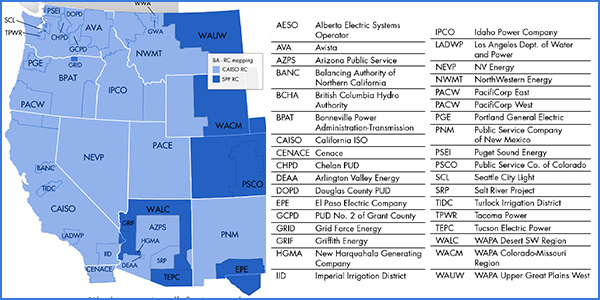By Robert Mullin
CAISO cleared a big hurdle in its nearly yearlong sprint to become the primary reliability coordinator (RC) in the Western Interconnection as FERC approved a set of Tariff revisions covering the ISO’s new services.
“Today we’ve got some good news from FERC in terms of our ability to move forward,” CAISO Regional Integration Director Phil Pettingill told a meeting of the ISO’s Board of Governors after the order was issued Wednesday.
Pettingill said the FERC order will allow the ISO to start signing binding agreements to provide RC services with two dozen entities across the Western Interconnection. About 72% of the region’s load is now poised to sign on with CAISO, compared with 12% for SPP. BC Hydro is proceeding with plans to stand up RC services for its own territory in British Columbia, representing about 7% of load in the area overseen by the Western Electricity Coordinating Council. (See CAISO RC Wins Most of the West.)
The Tariff revisons approved by FERC create a new section containing CAISO’s RC provisions while also providing a pro forma service agreement and designating a rate schedule to implement service charges (ER18-2366). The commission’s approval of the service agreement means CAISO can begin onboarding RC customers starting Thursday.
CAISO’s filing spelled out the functions applicable to an RC under NERC reliability standards, including providing outage coordination; performing operations planning analyses; conducting real-time assessments; monitoring and wide-area situational awareness; administering a system operating limit methodology; approving system restoration plans and facilitating system restoration drills; and issuing operating instructions to RC customers regarding their monitored facilities.
CAISO will also offer optional services such as hosted advanced network applications for a one-time charge of $35,000 to $70,000 (depending on the number of takers) and physical security reviews.
In approving CAISO’s RC provisions, FERC rejected protests by some market participants over the ISO’s proposal to assess volumetric service charges on generation-only balancing authorities.
The protesters, which include Avangrid, Calpine and Gridforce Energy Management, contended that the ISO’s charge, which will be based on annual net generation (NG) rather than net energy for load (NEL), deviates from commission precedent for allocating reliability-associated costs. They argue that an NG-based methodology is unjust and unreasonable because it double charges end users for energy produced in generation-only balancing areas. Peak Reliability currently charges such BAs based on NEL, which translates into minimum assessment rather than a volumetric charge.
“In effect, protesters argue that CAISO will assess a transaction that is sourced from a generation-only balancing authority reliability costs both for its exports from a generation-only balancing authority and its imports to a traditional balancing authority,” the commission noted.
The protesters further contended the NG methodology violates cost-causation principles because generation-only BAs require less RC service than BAs with load. They said CAISO had performed no analysis on the relative level of oversight costs for either type of BA.
But FERC sided with CAISO on the issue, saying neither the Federal Power Act nor commission precedent dictate a just and reasonable rate methodology for RC service. The commission also determined that CAISO’s proposed allocation methodology will not result in double-charging.
The commission also rejected the contention the ISO’s approach violates cost-causation principles, noting that none of the protesters argued that generation-only BAs do not require or benefit from RC services.
“Rather, protesters assert that CAISO has not justified charging them a rate that they assert will be significantly higher than the rate charged by Peak Reliability,” the commission wrote. “Moreover, protesters argue that the RC services required for generation-only balancing authorities are substantially less burdensome as compared to those of a traditional balancing authority with load. CAISO, however, specifically identifies core services that an RC provides and explains that traditional balancing authorities and generation-only balancing authorities all use the vast majority of these core services.”
While FERC’s decision is significant, CAISO’s RC effort is still subject to WECC and NERC certification next year. Still, CAISO is poised to lead the way in effort to fill the void being left by Peak.
Pettingill told Wednesday’s board meeting that the ISO had been holding roundtable meetings with SPP, the Alberta Electric System Operator, BC Hydro and Peak to coordinate the transition to a post-Peak West. When the question arose as to who will manage the Western system model, he said, roundtable participants decided it should be CAISO.
The ISO also intends to hold a series of public meetings to address concerns, either quarterly or “as many as needed,” he said.
Hudson Sangree contributed to this article.





